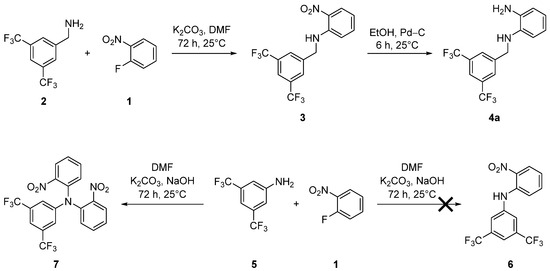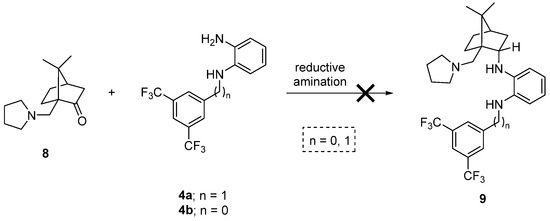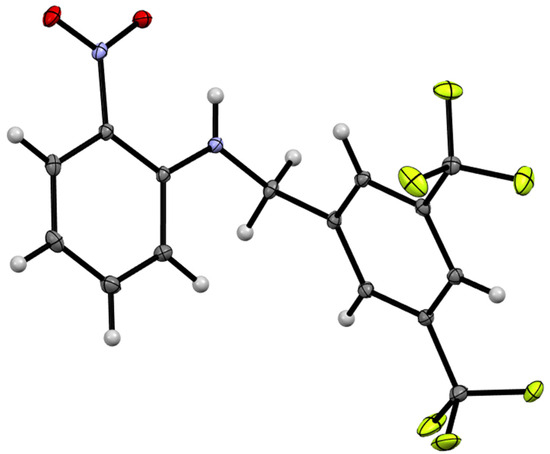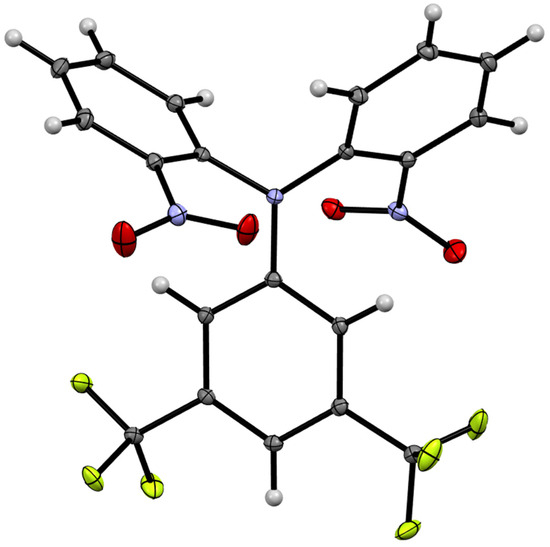Abstract
A monosubstituted benzene-1,2-diamine building block, N1-(3,5-bis(trifluoromethyl)benzyl)benzene-1,2-diamine, was prepared in two steps from commercially available 3,5-bis(trifluoromethyl)benzylamine and 1-fluoro-2-nitrobenzene, while the use of 3,5-bis(trifluoromethyl)aniline as the starting amine gave a triarylamine, N,N-bis(2-nitrophenyl)-3,5-bis(trifluoromethyl)aniline. The structures of the newly synthesized compounds were fully characterized.
1. Introduction
The synthesis of diaminobenzene derivatives is widely known. Substituted diaminobenzenes have found innumerable applications. They are important starting materials for the formation of arylbenzimidazoles, benzotriazolium salts, and biologically active compounds, among others. Substituted diaminobenzenes are used as starting materials for the preparation of arylbenzimidazole-based organic light-emitting diodes [1,2,3]. Benzotriazolium salts prepared by reaction of substituted benzenediamines with tert-butyl nitrite followed by treatment with trimethyloxonium tetrafluoroborate are used as a Lewis acid catalyst in the Nazarov reaction [4]. Dihydrotetraazaanthracenes have been prepared by cyclization of N-substituted orto-phenylenediamines as new materials for use in organic electronic devices [5]. 1,2-Disubstituted benzimidazoles based on substituted diaminobenzenes have been tested for their cytotoxicity against cancer cells [6,7]. Benzene-1,2-diamine derivatives have been tested as donors for double hydrogen bond donors in non-covalent organocatalysts [8]. Triphenylamine-based diamines are important and versatile monomers for the synthesis of aromatic polyamides with different properties [9,10,11,12,13,14,15].
Recently, we reported the synthesis and catalytic activity of (S)-quininamine-based organocatalysts bearing benzene-1,2-diamine as hydrogen bond donors. Benzene-1,2-diamine-based organocatalysts were prepared in a three-step synthesis from (S)-quininamine and 1-fluoro-2-nitrobenzene. Most of the synthesized catalysts possessed an amino group functionalized with methylenemalonitrile [8]. The same three-step methodology was used to attempt to prepare a camphor-derived analogue. Unfortunately, undesirable camphor-derived benzo[d]imidazole was obtained [16]. Attempts to introduce the 3,5-bis(trifluoromethyl)benzyl group and the 3,5-bis(trifluoromethyl)phenyl group on the primary amino group were unsuccessful [16]. Therefore, an alternative approach to access benzene-1,2-diamine camphor derivatives of type 9 with 3,5-bis(trifluoromethyl)benzyl group and/or 3,5-bis(trifluoromethyl)phenyl group was developed starting from N1-(3,5-bis(trifluoromethyl)benzyl)benzene-1,2-diamine (4a) or N1-(3,5-bis(trifluoromethyl)phenyl)benzene-1,2-diamine (4b) and 10-pyrrolidinecamphor 8 [17] by reductive amination.
In this work, we present the synthesis of N1-(3,5-bis(trifluoromethyl)benzyl)benzene-1,2-diamine (4a) and N,N-bis(2-nitrophenyl)-3,5-bis(trifluoromethyl)aniline (7), as well as an experiment on the reductive amination of 10-pyrrolidinecamphor 8 with N1-(3,5-bis(trifluoromethyl)benzyl)benzene-1,2-diamine (4a).
2. Results and Discussion
N1-(3,5-Bis(trifluoromethyl)benzyl)benzene-1,2-diamine (4a) was prepared in two steps from commercially available 3,5-bis(trifluoromethyl)benzylamine (2) and 1-fluoro-2-nitrobenzene (1) (Scheme 1). In the first step, nucleophilic aromatic substitution gave the N-substituted nitroaniline 3 at a 98% yield. Subsequent catalytic hydrogenation of 3 afforded the desired diamine 4a at a 97% yield. The product 4a was clean enough for further synthesis and was not subjected to additional purification. If necessary, the diamine 4a can be easily purified by column chromatography using a mixture of EtOAc/petroleum ether in a 1:2 ratio on silica gel 60 as a stationary phase. In contrast, the preparation of N1-(3,5-bis(trifluoromethyl)phenyl)benzene-1,2-diamine (4b) [4,18] from 3,5-bis(trifluoromethyl)aniline (5) and 1-fluoro-2-nitrobenzene (1) did not afford the corresponding nitroaniline 6. Instead, the double nucleophilic aromatic substitution product 7 was isolated at a 20% yield. Finally, attempts to prepare the desired benzene-1,2-diamine camphor derivative 9 from diamine 4a and 10-pyrrolidinecamphor 8 [17] by reductive amination with NaBH3CN failed (Scheme 2) [19].

Scheme 1.
Synthesis of benzenediamine 4a and a double nucleophilic aromatic substitution product 7.

Scheme 2.
Attempted synthesis of camphor-derived noncovalent bifunctional organocatalysts of type 9.
The structures of compounds 3, 4a, and 7 were confirmed by spectroscopic methods (1H- and 13C-NMR, DEPT 135, 2D-NMR, IR, and high-resolution mass spectrometry) (Supplementary Materials). The structures of compounds 3 and 7 were additionally confirmed by single-crystal X-ray diffraction analysis (Figure 1 and Figure 2).

Figure 1.
Molecular structure of product 3. Thermal ellipsoids are shown at 50% probability.

Figure 2.
Molecular structure of product 7. Thermal ellipsoids are shown at 50% probability.
In summary, compounds 3, 4a, and 7 have been prepared and fully characterized and are now available to the scientific community.
3. Materials and Methods
Solvents for extractions and chromatography were of technical grade and were distilled prior to use. Extracts were dried over technical grade anhydrous Na2SO4. Melting points were determined on a Kofler micro hot stage and on SRS OptiMelt MPA100—Automated Melting Point System (Stanford Research Systems, Sunnyvale, CA, USA). The NMR spectra were obtained on a Bruker UltraShield 500 plus (Bruker, Billerica, MA, USA) at 500 MHz for 1H and 126 MHz for 13C nucleus, using CDCl3 with TMS as the internal standard, as solvents. Mass spectra were recorded on an Agilent 6224 Accurate Mass TOF LC/MS (Agilent Technologies, Santa Clara, CA, USA), IR spectra on a Perkin–Elmer Spectrum BX FTIR spectrophotometer (PerkinElmer, Waltham, MA, USA). Column chromatography (CC) was performed on silica gel (Silica gel 60, particle size: 0.035–0.070 mm (Sigma-Aldrich, St. Louis, MI, USA)). All the commercially available chemicals used were purchased from Sigma-Aldrich (St. Louis, MI, USA). Catalytic hydrogenation was performed on a Parr Pressure Reaction Hydrogenation Apparatus (Moline, IL, USA).
3.1. Synthesis of N-(3,5-Bis(trifluoromethyl)benzyl)-2-nitroaniline (3)
A mixture of (3,5-bis(trifluoromethyl)phenyl)methanamine (2) (10 mmol, 2.43 g), 1-fluoro-2-nitrobenzene (1) (10 mmol, 1.05 mL), and K2CO3 (10 mmol, 1.38 g), in anhydrous DMF (20 mL) was stirred at 25 °C for 72 h. The reaction mixture was diluted with H2O (40 mL) and extracted with EtOAc (3 × 20 mL). The combined organic phase was dried over anhydrous Na2SO4 and filtered, and the volatile components were evaporated in vacuo. Yield: 3.93 g (10.8 mmol, 98%) of yellow solid; mp = 111.0–112.0 °C. EI-HRMS: m/z = 365.0729 (MH+); C15H11F6N2O2 requires: m/z = 365.0725 (MH+); νmax 3399, 1619, 1572, 1511, 1451, 1433, 1417, 1367, 1348, 1330, 1283, 1247, 1229, 1161, 1140, 1116, 1093, 1039, 988, 926, 907, 884, 859, 844, 742, 707, 683 cm−1. 1H-NMR (500 MHz, DMSO-d6): δ = 4.84 (d, J = 6.4, 2H), 6.71 (ddd, J = 1.2, 6.9, 8.3, 1H), 6.94 (dd, J = 1.2, 8.7, 1H), 7.47 (ddd, J = 1.6, 6.8, 8.6, 1H), 8.00 (s, 1H), 8.10 (dd, J = 1.6, 8.6, 1H), 8.13 (s, 2H), 8.82 (t, J = 6.5, 1H, NH). 13C-NMR (126 MHz, DMSO-d6): δ = 44.79, 114.59, 115.87, 120.89 (p, J = 3.8), 123.36 (q, J = 272.9), 126.40, 127.92 (q, J = 4.0), 130.32 (q, J = 32.8), 131.80, 136.51, 142.79, 144.34.
3.2. Synthesis of N1-(3,5-Bis(trifluoromethyl)benzyl)benzene-1,2-diamine (4a)
A mixture of N-(3,5-bis(trifluoromethyl)benzyl)-2-nitroaniline (3) (10.8 mmol, 3.93 g) and Pd–C (ω = 10%, 100 mg) in EtOH (50 mL) was shaken in a Paar shaker hydrogenation apparatus in H2 atmosphere (4 bar) at 25 °C for 6 h. The reaction mixture was filtrated through a plague of Celite® to remove Pd–C, and the volatile components were evaporated in vacuo. The product 4a was clean enough for further synthesis and was not additionally purified. If needed, the product can easily be purified by column chromatography (Silica Gel 60; EtOAc/petroleum ether = 1:2). The oily product turned dark, even though it was stored under Argon. Yield: 3.50 g (10.5 mmol, 97%) of brownish oil. EI-HRMS: m/z = 335.0979 (MH+); C15H13F6N2 requires: m/z = 335.0983 (MH+); νmax 3337, 1621, 1507, 1454, 1377, 1351, 1314, 1274, 1167, 1120, 996, 884, 844, 741, 704, 681 cm−1. 1H-NMR (500 MHz, DMSO-d6): δ = 4.51 (d, J = 5.1 Hz, 2H), 4.61 (s, 2H), 5.36 (t, J = 7.1 Hz, 1H), 6.34 (dd, J = 7.2, 2.0 Hz, 1H), 6.40–6.49 (m, 2H), 6.60 (dd, J = 7.0, 2.1 Hz, 1H), 7.94 (s, 1H), 8.08 (s, 2H). 13C-NMR (126 MHz, DMSO-d6): δ = 46.00, 110.55, 114.47, 117.46, 117.63, 120.22–120.39 (m), 123.46 (q, J = 272.7 Hz), 127.89 (d, J = 3.8 Hz), 130.08 (q, J = 32.6 Hz), 134.85, 135.55, 144.65.
3.3. Synthesis of N,N-Bis(2-nitrophenyl)-3,5-bis(trifluoromethyl)aniline (7)
A mixture of 3,5-bis(trifluoromethyl)aniline (5) (5 mmol, 777 μL), 1-fluoro-2-nitrobenzene (1) (5 mmol, 525 μL), K2CO3 (5 mmol, 691 mg), and NaOH (7 mmol, 280 mg) in anhydrous DMF (10 mL) was stirred at 25 °C for 72 h. The reaction mixture was diluted with H2O (30 mL) and extracted with EtOAc (3 × 15 mL). The combined organic phase was dried over anhydrous Na2SO4 and filtered, next the volatile components were evaporated in vacuo. The residue was purified by column chromatography (Silica Gel 60; EtOAc/petroleum ether = 1:10). Fractions containing the product 7 were combined, and the volatile components were evaporated in vacuo. Yield: 482 mg (1.02 mmol, 20%) of yellowish solid; mp = 142–147 °C. EI-HRMS: m/z = 472.0726 (MH+); C20H12F6N3O4 requires: m/z = 472.0732 (MH+); νmax 3341, 3098, 1598, 1578, 1525, 1478, 1466, 1381, 1353, 1338, 1279, 1267, 1166, 1120, 1045, 1000, 986, 961, 932, 903, 878, 848, 837, 776, 757, 744, 722, 702, 682, 633 cm−1. 1H-NMR (500 MHz, DMSO-d6): δ = 7.20 (s, 2H), 7.50 (dd, J = 8.2, 1.3 Hz, 2H), 7.60 (ddd, J = 8.4, 7.5, 1.3 Hz, 2H), 7.71 (s, 1H), 7.82 (td, J = 7.8, 1.6 Hz, 2H), 8.09 (dd, J = 8.2, 1.5 Hz, 2H). 13C-NMR (126 MHz, DMSO-d6): δ = 115.23–116.46 (m), 118.69, 122.71 (q, J = 272.9 Hz), 126.28, 127.87, 129.97, 131.59 (q, J = 33.1 Hz), 135.34, 136.65, 144.85, 147.05.
3.4. X-ray Crystallography
Single-crystal X-ray diffraction data were collected on an Agilent Technologies SuperNova Dual diffractometer with an Atlas detector using monochromated Cu-Kα radiation (λ = 1.54184 Å) at 150 K. The data were processed using CrysAlis PRO [20]. Using Olex2.1.2. [21], the structures were solved by direct methods implemented in SHELXS [22] or SHELXT [23] and refined by a full-matrix least-squares procedure based on F2 with SHELXT-2014/7 [24]. All nonhydrogen atoms were refined anisotropically. Hydrogen atoms were placed in geometrically calculated positions and were refined using a riding model. The drawings and the analysis of the bond lengths, angles, and intermolecular interactions were carried out using Mercury [25] and Platon [26]. Structural and other crystallographic details on data collection and refinement for compounds 3 and 7 were deposited with the Cambridge Crystallographic Data Centre as supplementary publication number CCDC Deposition Numbers 2287121 and 2284800, respectively. These data can be obtained free of charge via www.ccdc.cam.ac.uk/conts/retrieving.html (accessed on 29 August 2023) or from the CCDC, 12 Union Road, Cambridge CB2 1EZ, UK; fax: +44-1223-336033; e-mail: deposit@ccdc.cam.ac.uk.
Supplementary Materials
The following are available online: Synthesis and characterization data; Copies of 1H- and 13C-NMR spectra; Copies of 2D spectra; Copies of HRMS reports; Copies of IR spectra; Structure determination by X-ray diffraction analysis.
Author Contributions
Conceptualization, L.C., U.G., J.S. and B.Š.; methodology, L.C. and U.G.; software, L.C., H.B., U.G., J.S. and B.Š.; validation, L.C., H.B., U.G., J.S., F.P. and B.Š.; formal analysis, U.G., H.B. and L.C.; investigation, L.C. and U.G.; resources, L.C., U.G. and J.S.; data curation, L.C., H.B., U.G., J.S. and B.Š.; writing—original draft preparation, L.C., U.G., J.S. and B.Š.; writing—review and editing, L.C., U.G., J.S., F.P. and B.Š.; visualization, L.C., H.B., U.G., B.Š. and J.S.; supervision, U.G.; project administration, U.G. and J.S.; funding acquisition, U.G. and J.S. All authors have read and agreed to the published version of the manuscript.
Funding
This research was funded by the Slovenian Research Agency through grant P1-0179.
Data Availability Statement
Not applicable.
Acknowledgments
We thank the EN-FIST Centre of Excellence, Dunajska 156, 1000 Ljubljana, Slovenia, for the use of their BX FTIR spectrophotometer and Agilent 1260 Infinity LC for the HPLC analyses.
Conflicts of Interest
The authors declare no conflict of interest.
References
- Lee, Y.S.; Kim, M.S.; Kim, Y.C.; Lee, H.; Gao, C.; Ahn, K.-H. A New Blue Light-Emitting Material with Phenylbenzimidazole Moiety and Its Electroluminescence Properties. Mol. Cryst. Liq. Cryst. 2009, 513, 311–319. [Google Scholar] [CrossRef]
- Lai, M.-Y.; Chen, C.-H.; Huang, W.-S.; Lin, J.T.; Ke, T.-H.; Chen, L.-Y.; Tsai, M.-H.; Wu, C.-C. Benzimidazole/Amine-Based Compounds Capable of Ambipolar Transport for Application in Single-Layer Blue-Emitting OLEDs and as Hosts for Phosphorescent Emitters. Angew. Chem. Int. Ed. 2008, 47, 581–585. [Google Scholar] [CrossRef] [PubMed]
- Yang, X.; Zheng, S.; Bottger, R.; Chae, H.S.; Tanaka, T.; Li, S.; Mochizuki, A.; Jabbour, G.E. Efficient Fluorescent Deep-Blue and Hybrid White Emitting Devices Based on Carbazole/Benzimidazole Compound. J. Phys. Chem. C 2011, 115, 14347–14352. [Google Scholar] [CrossRef]
- Danelzik, T.; Joseph, S.; Mück-Lichtenfeld, C.; Daniliuc, C.G.; Mancheño, O.G. Benzotriazolium Salts: Emergent Readily Accessible Bench-Stable Lewis Acid Catalysts. Org. Lett. 2022, 24, 6105–6110. [Google Scholar] [CrossRef]
- Gampe, D.M.; Kaufmann, M.; Jakobi, D.; Sachse, T.; Presselt, M.; Beckert, R.; Gçrls, H. Stable and Easily Accessible Functional Dyes: Dihydrotetraazaanthracenes as Versatile Precursors for Higher Acenes. Chem. Eur. J. 2015, 21, 7571–7581. [Google Scholar] [CrossRef] [PubMed]
- Hue, B.T.B.; Nguyen, H.M.; Van Hieu, M.; Thanh, D.L.D.; Son, N.H.; De, T.Q.; Morita, H. Facile sodium metabisulfite mediated synthesis of 1,2-disubstituted benzimidazoles and cytotoxicity evaluation. Heterocycles 2019, 98, 650–665. [Google Scholar] [CrossRef]
- Olyaei, A.; Sadeghpour, M. A review on lawsone-based benzo[a]phenazin-5-ol: Synthetic approaches and reactions. RSC Adv. 2022, 12, 13837–13895. [Google Scholar] [CrossRef] [PubMed]
- Ciber, L.; Požgan, F.; Brodnik, H.; Štefane, B.; Svete, J.; Grošelj, U. Synthesis and Catalytic Activity of Organocatalysts Based on Enaminone and Benzenediamine Hydrogen Bond Donors. Catalysts 2022, 12, 1132. [Google Scholar] [CrossRef]
- Hsiaoa, S.-H.; Wu, C.-N. Solution-processable and electroactive aromatic polyamides with 3,5-bis(trifluoromethyl)triphenylamine moiety. Polym. Int. 2017, 66, 916–924. [Google Scholar] [CrossRef]
- Song, Y.; Zhao, L.; Yao, H.; Tian, Y.; Zhu, S.; Guan, S. Novel Hyperbranched Polyimides Bearing Bis(trifluoromethyl)-triphenylamine Moiety: Preparation and Rewritable Nonvolatile Memory Behaviours. ChemistrySelect 2021, 6, 2516–2522. [Google Scholar] [CrossRef]
- Constantina, C.-P.; Damaceanua, M.-D.; Brumaa, M.; Begunovb, R.S. Ortho-CATENATION and trifluoromethyl graphting as driving forces in electro-optical properties modulation of ethanol soluble triphenylamine-based polyimides. Dyes Pigm. 2019, 163, 126–137. [Google Scholar] [CrossRef]
- Lee, M.S.; Kim, S.Y. Synthesis of Poly(arylene ether)s Containing Triphenylamine Units via Nitro Displacement Reaction. Macromolecules 2005, 38, 5844–5845. [Google Scholar] [CrossRef]
- Hsiao, S.-H.; Wu, C.-N. Synthesis and Properties of Redox-Active Polyimides with 3,5-Bis (trifluoromethyl)- or 3,5-Dimethyl-Substituted Triphenylamine Groups. Polym.-Plast. Technol. Mater. 2017, 56, 1274–1285. [Google Scholar] [CrossRef]
- Song, G.; Wang, L.; Liu, D.; Yao, J.; Cao, Y. Gas transport properties of polyimide membranes based on triphenylamine unit. High Perform. Polym. 2018, 30, 100–108. [Google Scholar] [CrossRef]
- Hsiao, S.-H.; Wu, C.-N. Synthesis and Properties of Fully Triphenylamine-based Polyamides Bearing 3,5-bis(Trifluoromethyl) and/or 3,5-dimethyl Substituents on the Pendent Phenyl Units. Polym.-Plast. Technol. Mater. 2017, 56, 1236–1246. [Google Scholar] [CrossRef]
- Ciber, L.; Požgan, F.; Svete, J.; Štefane, B.; Grošelj, U. 1-{(1S,2S,4R)-7,7-Dimethyl-1-[(pyrrolidin-1-yl)methyl]bicyclo[2.2.1]heptan-2-yl}-1H-benzo[d]imidazole. Molbank 2023, 2023, M1538. [Google Scholar] [CrossRef]
- Ričko, S.; Svete, J.; Štefane, B.; Perdih, A.; Golobič, A.; Meden, A.; Grošelj, U. 1,3-Diamine-Derived Bifunctional Organocatalyst Prepared from Camphor. Adv. Synth. Catal. 2016, 358, 3786–3796. [Google Scholar] [CrossRef]
- Kirsch, P.; Schönleben-Janas, A.; Schirmer, R.H. Synthesis and Characterization of Water-Soluble and Photolabile10-Arylisoalloxazines: Tools for Studying the Mechanism of Action of Flavin-Type Antimalarials. Liebigs Ann. 1995, 1995, 1275–1281. [Google Scholar] [CrossRef]
- Lewin, G.; Schaeffer, C. One-Pot Access to 2,3-Disubstituted 1,2,3,4-Tetrahydroquinolines by Reductive Amination of Aldehydes with Sodium Cyanoborohydride. Heterocycles 1998, 48, 171–174. [Google Scholar] [CrossRef]
- CrysAlis PRO; Agilent Technologies UK Ltd.: Yarnton, UK, 2011.
- Dolomanov, O.V.; Bourhis, L.J.; Gildea, R.J.; Howard, J.A.K.; Puschmann, H. OLEX2: A complete structure solution, refinement and analysis program. J. Appl. Cristallogr. 2009, 42, 339–341. [Google Scholar] [CrossRef]
- Sheldrick, G.M. A short history of SHELX. Acta Crystallogr. A 2008, 64, 112–122. [Google Scholar] [CrossRef] [PubMed]
- Sheldrick, G.M. SHELXT-Integrated space-group and crystal-structure determination. Acta Crystallogr. Sect. Found. Adv. 2015, 71, 3–8. [Google Scholar] [CrossRef]
- Sheldrick, G.M. Crystal structure refinement with SHELXL. Acta Crystallogr. Sect. C Struct. Chem. 2015, 71, 3–8. [Google Scholar] [CrossRef] [PubMed]
- Macrae, C.F.; Edgington, P.R.; McCabe, P.; Pidcock, E.; Shields, G.P.; Taylor, R.; Towler, M.; van de Streek, J. Mercury: Visualization and analysis of crystal structures. J. Appl. Crystallogr. 2006, 39, 453–457. [Google Scholar] [CrossRef]
- Spek, A.L. Single-crystal structure validation with the program PLATON. J. Appl. Crystallogr. 2003, 36, 7–13. [Google Scholar] [CrossRef]
Disclaimer/Publisher’s Note: The statements, opinions and data contained in all publications are solely those of the individual author(s) and contributor(s) and not of MDPI and/or the editor(s). MDPI and/or the editor(s) disclaim responsibility for any injury to people or property resulting from any ideas, methods, instructions or products referred to in the content. |
© 2023 by the authors. Licensee MDPI, Basel, Switzerland. This article is an open access article distributed under the terms and conditions of the Creative Commons Attribution (CC BY) license (https://creativecommons.org/licenses/by/4.0/).